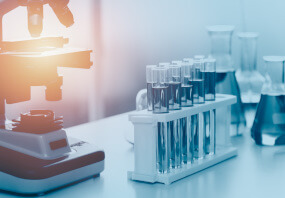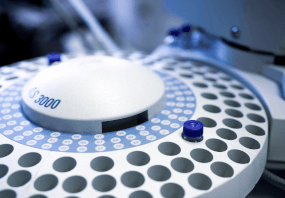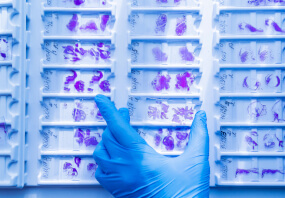General description
Free form:
Excitation: 503 nm (0.01 M phosphate buffer, pH 7.0 containing 0.1 mM EDTA); 550 nm
Emission: 675 nm (0.01 M phosphate buffer, pH 7.0 containing 0.1 mM EDTA); 672 nm
DNA Complex:
Excitation: 543 nm; 555 nm
Emission: 655 nm; 665 nm
Application
Fluorescent DNA stain. A featured product for Apoptosis research.
Biochem/physiol Actions
7-AAD is used in flow cytometry analysis of viable cells. 7-ADD is a fluorescent indicator that undergoes a spectral shift upon association with DNA. Su, X., et al. used FITC and PE-conjugated antibodies to stain cell surface markers. After cell-surface marker staining, cells were further stained with 10 μg/ml of 7-AAD in PBS on ice for 30 minutes. After washing with PBS twice, the cells were fixed in 1% paraformaldehyde supplemented with 50 μg/ml actinomycin D. Non-apoptotic cells were 7-AAD negative. 7-AAD like its parent molecule, Actinomycin D, is a DNA-intercalator with growth-inhibitory properties.
7-amino-actinomycin D (7-AAD) is a DNA dye. It can be used as a replacement for propidium iodide (PI) for the discrimination of dead cells. This dye is ideal for dead cell discrimination in long-lasting experiments, as it is efficiently exempted by intact cells and has a high DNA binding constant.
Reconstitution
Solution of 1 mg/ml in DMSO:H2O (1:1) is stable for at least 2 years at −20 °C without loss of activity. According to Su et al., the provided solution should be diluted to 10 μg/ml (1:100) working concentration in PBS and is therefore sufficient for 100 stain reactions.
- UPC:
- 41116113
- Condition:
- New
- Availability:
- 3-5 Days
- Weight:
- 1.00 Ounces
- HazmatClass:
- No
- MPN:
- SML1633-1ML
- CAS:
- 7240-37-1












